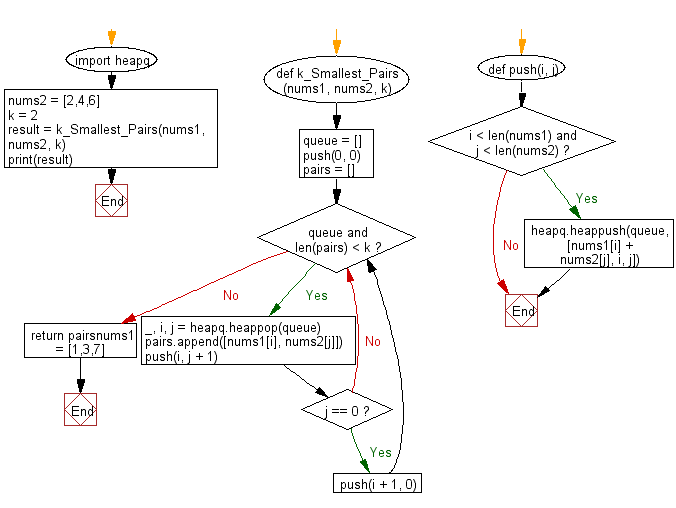Python: Find k number of pairs which consists of one element from the first array and one element from the second array
Python heap queue algorithm: Exercise-17 with Solution
You are given two integer arrays sorted in ascending order and an integer k. Write a Python program to find k number of pairs (u, v) which consists of one element from the first array and one element from the second array using Heap queue algorithm.
Sample Solution:
Python Code:
import heapq
def k_Smallest_Pairs(nums1, nums2, k):
queue = []
def push(i, j):
if i < len(nums1) and j < len(nums2):
heapq.heappush(queue, [nums1[i] + nums2[j], i, j])
push(0, 0)
pairs = []
while queue and len(pairs) < k:
_, i, j = heapq.heappop(queue)
pairs.append([nums1[i], nums2[j]])
push(i, j + 1)
if j == 0:
push(i + 1, 0)
return pairs
nums1 = [1,3,7]
nums2 = [2,4,6]
k = 2
result = k_Smallest_Pairs(nums1, nums2, k)
print(result)
Sample Output:
[[1, 2], [1, 4]]
Flowchart:

Visualize Python code execution:
The following tool visualize what the computer is doing step-by-step as it executes the said program:
Python Code Editor:
Have another way to solve this solution? Contribute your code (and comments) through Disqus.
Previous: Write a Python program which add integer numbers from the data stream to a heapq and compute the median of all elements.
What is the difficulty level of this exercise?
Test your Python skills with w3resource's quiz
Python: Tips of the Day
Creates a dictionary with the same keys as the provided dictionary and values generated by running the provided function for each value:
Example:
def tips_map_values(obj, fn):
ret = {}
for key in obj.keys():
ret[key] = fn(obj[key])
return ret
users = {
'Owen': { 'user': 'Owen', 'age': 29 },
'Eddie': { 'user': 'Eddie', 'age': 15 }
}
print(tips_map_values(users, lambda u : u['age'])) # {'Owen': 29, 'Eddie': 15}
Output:
{'Owen': 29, 'Eddie': 15}
- New Content published on w3resource:
- Scala Programming Exercises, Practice, Solution
- Python Itertools exercises
- Python Numpy exercises
- Python GeoPy Package exercises
- Python Pandas exercises
- Python nltk exercises
- Python BeautifulSoup exercises
- Form Template
- Composer - PHP Package Manager
- PHPUnit - PHP Testing
- Laravel - PHP Framework
- Angular - JavaScript Framework
- React - JavaScript Library
- Vue - JavaScript Framework
- Jest - JavaScript Testing Framework
